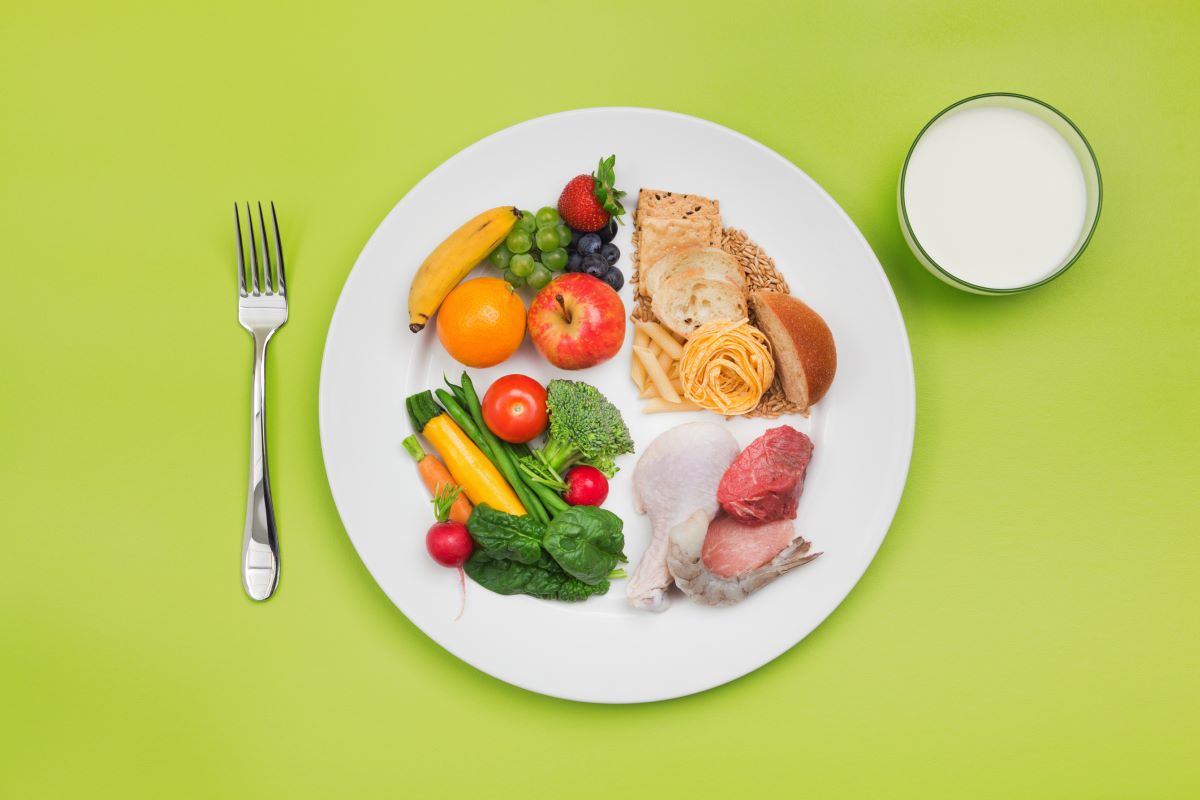
In 2011, the U.S. Department of Agriculture (USDA) replaced the food pyramid with MyPlate, offering a more personalized approach to healthy eating.
MyPlate is a simple, colored visualization of the five food groups divided on a 9-inch plate: protein, fruit, vegetables, grains and dairy.
Various teaching tools are available, including MyPlate Kitchen, MyPlate Plan, MyPlate on Alexa and the Start Simple with MyPlate app. Users can get a personalized plan of recommended servings for each food group and calories.
Aim for ¼ fruit, ¼ vegetables, ¼ grains and ¼ protein on your plate at most meals.
Each food group includes information on daily servings, nutrients, health benefits, a tip sheet and a quiz. The amount you need daily from each food group depends on your age, gender, height, weight and activity level.
Choosing a variety of foods, including different colors, encourages healthier eating. The benefits add up over time — small changes matter. For an idea of what a serving size of a particular food looks like, check out the Food Group Gallery.
Here are some helpful tips for each food group.
Fruit
- Serving size: 1 cup of fruit, ½ cup of dried fruit or 1 cup of 100% fruit juice. One-quarter of the plate is recommended — include more whole fruit rather than juice.
- Nutrients: Fruit provides essential nutrients like potassium, fiber, vitamin C and folate. Examples include bananas, prunes, apricots, cantaloupe and orange juice.
- Health benefits: As part of a healthy diet, fruits can help reduce the risk of heart disease and stroke, lower calorie levels and may protect against certain cancers.
Vegetables
- Serving size: 1 cup of raw or cooked vegetables or vegetable juice, or 2 cups of raw, leafy salad greens.
- Nutrients: Like fruit, vegetables contain many nutrients, including potassium, fiber, vitamin C, vitamin A and folate. Examples include spinach, squash, broccoli, lentils, beans and peas.
- Health benefits: Vegetables may help maintain healthy blood pressure, lower calories in the diet, reduce the risk of stroke and protect against certain cancers.
Grains
- Serving size: A “1-ounce equivalent” equals a slice of bread, 1 cup of ready-to-eat cereal or ½ cup of cooked rice or pasta.
- Nutrients: Grains are good sources of fiber, complex carbohydrates, several B vitamins, iron, magnesium, folic acid and selenium. Examples include bread, popcorn, pasta, grits, rice, oatmeal and tortillas. There are two types of grains:
whole and refined.
- Health benefits: Fiber from whole grains may help reduce cholesterol levels, lower the risk of heart disease, create a feeling of fullness, aid in weight management and contribute to healthy digestion.
- Whole grains contain the entire grain kernel: bran, germ and endosperm. Examples include whole wheat bread and brown rice. Half of your grain servings daily should be from whole grains.
- Refined grains have had the bran and germ removed, as well as iron, dietary fiber and many B vitamins, making them less nutritious than whole grains. Look for products labeled “100% whole grain.”
Protein
- Serving size: A 1-ounce equivalent equals 1 ounce of meat, poultry or seafood; ¼ cup of beans equals 2 ounces.
- Nutrients: Proteins provide many nutrients, including B vitamins, zinc, iron, vitamin E and magnesium. Protein sources include animal and plant sources — meat, poultry, seafood, beans, peas, lentils, eggs and soy products.
- Choose lean meats and skinless poultry more often — 8 ounces of seafood (such as salmon) is recommended weekly.
- Vegetarians can get plenty of protein by including a variety of sources and good portion sizes. Examples include eggs (for ovo-vegetarians), beans, peas, lentils, nuts, seeds, nut butters and soy products like tofu and tempeh.
- Health benefits: Proteins are building blocks for bones, muscles, blood, skin, enzymes, hormones and vitamins.
Dairy
- Serving size: 1 cup of milk, soymilk or yogurt, or 1 ½ ounces of natural cheese. Choose low-fat or fat-free options more often.
- Nutrients: Dairy products provide many healthy nutrients like calcium, phosphorus, vitamins A, D and B12, riboflavin, protein and potassium.
- Health benefits: Calcium promotes the building of bones and teeth. As you age, calcium helps maintain strong bones.
- Potassium helps maintain healthy blood pressure. Dairy sources are an excellent source of potassium.
- Vitamin D promotes bone growth and maintenance by helping the body maintain appropriate levels of calcium and phosphorus in the blood.
- For those who do not consume dairy products, choose products fortified with calcium and vitamins A and D to get the necessary nutrients.
In summary, when making healthy food choices, consider variety, serving size and nutrition to promote a healthier you.
Find more healthy eating tips from Northside Hospital Nutrition Services.
References:

